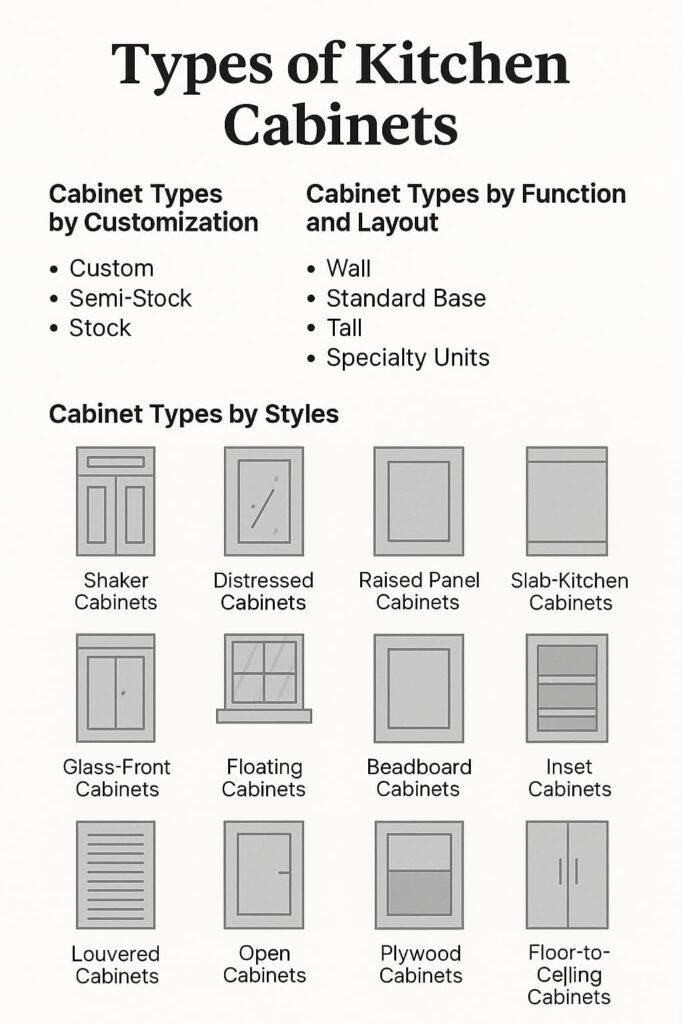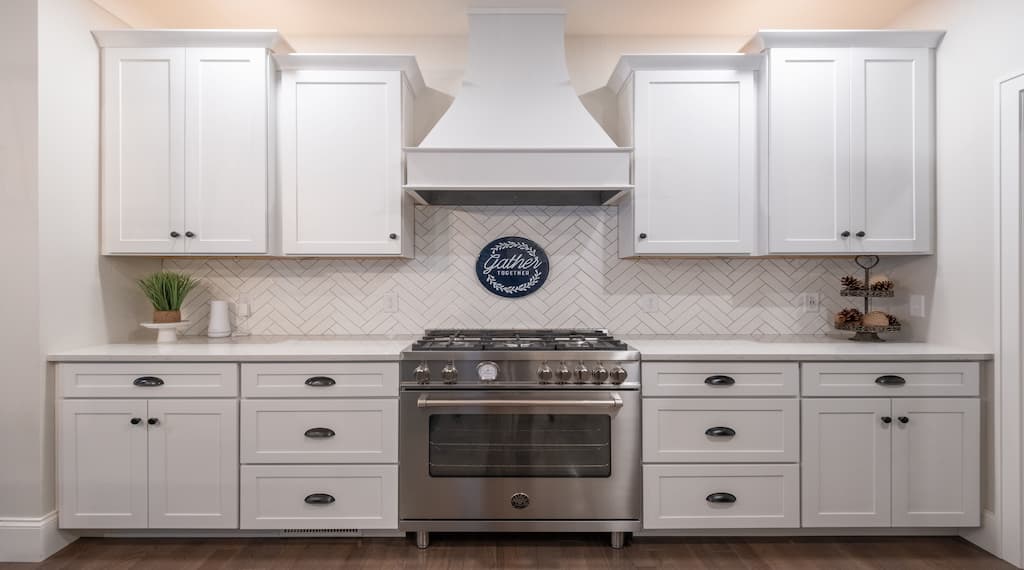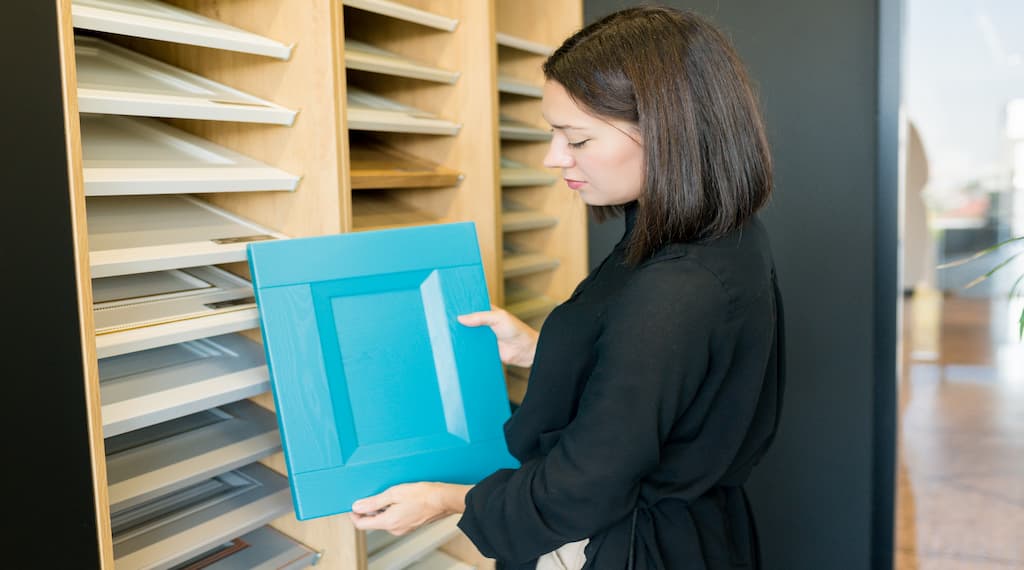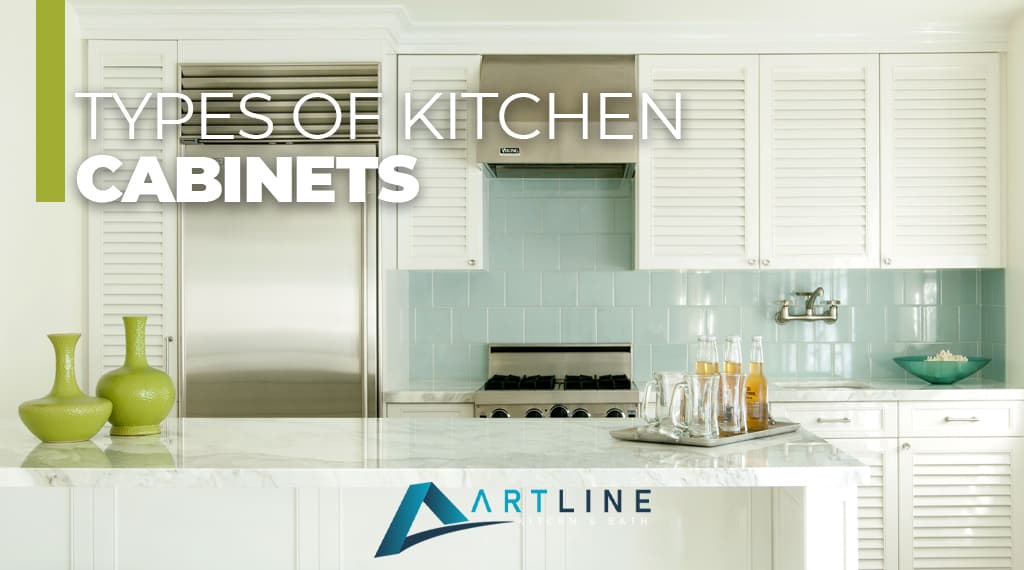Kitchen cabinets fall into three categories: customization level, layout, and style. Custom, semi-stock, and stock cabinets vary in flexibility and cost; stock options range from $100 to $400 per linear foot, semi-stock from $150 to $700, and custom from $500 to $1,200, with high-end projects exceeding $2,000 per linear foot.
Layout types include wall cabinets for upper storage, base cabinets for daily-use items, tall cabinets for pantry storage, and specialty units such as corner or island cabinets. Style options cover Shaker, slab, raised panel, inset, beadboard, glass-front, floating, and open designs, each bringing a unique look to the kitchen. Materials like plywood add strength, while glossy finishes enhance brightness and modern appeal.
With the right combination of structure, layout, and design, kitchen cabinets turn everyday storage into a functional and visually cohesive part of the home. The right cabinets don’t just hold what you need; they define how your kitchen works and feels.

Table of Contents
ToggleCabinet Types by Customization
Cabinet types by customization include custom, semi-stock, and stock cabinets, each offering varying levels of flexibility, pricing, and personalization. Understanding the differences between these types helps homeowners match their cabinet choices with their kitchen layout, design needs, and budget.
Custom Cabinets
Custom cabinets are built entirely to order, tailored to your kitchen’s specific dimensions, layout, and design requirements. Every component is made to fit your space precisely. Custom cabinets offer complete control over size, materials, finishes, hardware, and storage solutions. You can specify everything from cabinet height to interior accessories like spice pull-outs or vertical tray dividers.
Custom cabinets are ideal for kitchens with unusual layouts, high-end residential projects, or homeowners with specific design visions that off-the-shelf options can’t accommodate as well as luxury homes, design-driven remodels, and architectural kitchens where aesthetics and functionality must align perfectly.
Typically $500–$1,200 per linear foot. High-end models can exceed $2,000 per linear foot, meaning a 10-foot run might cost $5,000 to $12,000 or more, depending on materials and complexity.
Pros & Cons of Custom Cabinets
Pros:
- Custom cabinets offer unlimited design freedom, allowing homeowners to tailor every detail to their preferences.
- They perfectly fit any kitchen layout, including unusual or complex spaces.
- Premium materials are commonly used, ensuring long-lasting durability and a high-end finish.
- Superior craftsmanship enhances both the function and appearance of the cabinetry.
Cons:
Custom cabinets come with a high cost due to the level of detail and personalization involved.
They require a longer production timeline, with manufacturing and installation typically taking between 8 and 12 weeks.
Semi-Stock Cabinets
Semi-stock cabinets are pre-manufactured in standard sizes but offer customizable features such as door styles, finishes, and limited dimension adjustments. They use standard cabinet boxes but allow modifications like custom drawer fronts, crown moldings, and upgraded hardware. Lead times are shorter than custom but longer than stock.
Semi-stock cabinets are ideal for homeowners seeking design flexibility without committing to the cost and lead time of full custom cabinetry. They work well in kitchens with standard layouts that benefit from added personalization, mid-range residential remodels, and new builds where homeowners want freedom to choose finishes and features while controlling costs.
Between $150 and $700 per linear foot, meaning a 10-foot run would typically cost $1,500 to $7,000.
Pros & Cons of Semi-Custom Cabinets
Pros:
- Semi-stock cabinets are cost-effective, making them a practical choice for mid-range kitchen projects.
- They allow moderate customization, such as selecting finishes, hardware, and some sizing options.
- Delivery is quicker than fully custom cabinets, typically taking 4 to 8 weeks.
Cons:
- Customization is limited compared to fully custom cabinetry, with fewer options for adjusting dimensions, materials, and intricate design features.
Stock Cabinets
Stock cabinets are mass-produced in fixed sizes and sold ready-to-install, making them the most widely available and affordable cabinet type. They come in standard widths, typically increasing in 3-inch increments from 9 to 48 inches, and standard depths, usually 12 inches for wall cabinets and 24 inches for base cabinets. Design options are limited to predefined styles, finishes, and sizes, which makes them ideal for straightforward kitchen layouts.
Many stock cabinets are also available as RTA (Ready-to-Assemble) cabinets, which are delivered flat-packed and require on-site assembly. RTA cabinets offer the exact dimensions and finishes as pre-assembled stock options, but at slightly lower prices. Their compact packaging also reduces shipping costs, making them popular among budget-conscious renovators and DIY homeowners.
Stock cabinets are ideal for quick renovations, budget projects, rental properties, or kitchens with simple layouts that don’t require advanced customization. They are commonly used in DIY remodels, apartments, spec homes, and investment properties.
Cost Range: Between $100 and $400 per linear foot. A typical 10-foot run would cost between $1,000 and $4,000, depending on material, finish, and supplier.
Pros & Cons of Stock Cabinets
Pros:
- Stock cabinets offer the lowest upfront cost, making them ideal for budget-conscious projects.
- They are readily available and can be delivered quickly, helping speed up kitchen renovations.
- Many models come pre-assembled or as RTA (Ready-to-Assemble) units, which are easy to install or assemble on-site.
Cons:
- Design flexibility is limited, with a restricted range of sizes, finishes, and styles.
- Fixed sizing may not work well in kitchens with unique layouts or non-standard dimensions.
- They typically come with fewer premium material options than semi-stock or custom cabinets.
Cabinet Types by Function and Layout
Cabinet types by function and layout include wall cabinets, base cabinets, tall cabinets, and specialty units. Each plays a distinct role in organizing and optimizing the kitchen space. Understanding these categories helps homeowners build efficient kitchen systems tailored to cooking habits, appliance placement, and storage needs.
Wall Cabinets
Wall cabinets are mounted on the wall above countertops, sinks, or appliances and are used for storing lightweight items like dishes, glasses, and pantry goods. Wall cabinets are typically 12 to 24 inches deep and range in height from 12 to 42 inches. They come in various widths and can be installed at custom heights to suit ergonomic preferences or ceiling heights.
Wall cabinets are ideal for kitchens of all sizes, especially where vertical space needs to be maximized. They help keep essential items within reach while freeing up countertop and floor space. They are popular in all kitchen layouts, from compact apartment kitchens to expansive open-concept designs, where upper storage is necessary.
Pros & Cons of Wall Cabinets
Pros:
- Wall cabinets save valuable counter space by utilizing vertical areas for storage.
- They increase overall storage capacity, especially in smaller kitchens with limited floor space.
- These cabinets help keep the kitchen organized by providing designated areas for dishes, glassware, and pantry items.
Cons:
- In small kitchens, poor placement or oversized wall cabinets can make the space feel closed in.
- Items stored in taller or higher-mounted cabinets may be difficult to reach without a step stool or ladder.
Standard Base Cabinets
Standard base cabinets are installed directly on the floor and serve as the foundation for countertops and workspace in the kitchen. Base cabinets are typically 34.5 inches tall (without countertop) and 24 inches deep. They include configurations with doors, drawers, pull-outs, and combinations. Widths usually range from 12 to 48 inches.
Base cabinets are essential in any kitchen for storing heavier items like pots, pans, and small appliances. They support countertops and form the primary work zones. They are popular in every kitchen design, especially U-shaped and L-shaped layouts, where countertop and under-counter storage are priorities.
Pros & Cons of Standard Base Cabinets
Pros:
- Standard base cabinets are sturdy and provide a strong foundation for countertops and daily kitchen activities.
- They are highly versatile, accommodating drawers, shelves, and interior accessories like pull-out trays or organizers.
- These cabinets offer accessible storage for heavy items such as pots, pans, and small appliances.
Cons:
- They occupy a significant amount of floor space, which can limit movement in compact kitchens.
- Without careful planning, base cabinet layouts can result in hard-to-reach corners or underutilized storage areas.
Tall Cabinets
Tall cabinets, also known as pantry or utility cabinets, extend from floor to ceiling and provide large, vertical storage capacity. These cabinets range in height from 80 to 96 inches and are usually 12 to 24 inches deep. Interior options include adjustable shelves, roll-out trays, and appliance cutouts.
Tall cabinets are ideal for storing dry goods, cleaning supplies, and oversized kitchen items. They are also commonly used to house built-in appliances like wall ovens and microwaves. They are popular in modern kitchens, galley layouts, and designs that lack dedicated pantry rooms.
Pros & Cons of Tall Cabinets
Pros:
- Tall cabinets offer abundant vertical storage, ideal for storing pantry items, cleaning supplies, or small appliances.
- They help reduce countertop clutter by providing designated space for bulk and less-used items.
- When designed well, they can function as built-in pantry solutions, adding storage and value to the kitchen.
Cons:
- In small kitchens, tall cabinets may overwhelm the space and make it feel more confined.
- The upper sections can be challenging to access without a step stool or ladder.
- Poor placement may disrupt the kitchen’s visual openness and workflow.
Specialty Cabinets
Specialty cabinets are customized or purpose-built units designed to solve specific storage or layout challenges in the kitchen. Standard specialty units include corner cabinets (with Lazy Susans or pull-out trays), appliance garages, wine racks, and island cabinets. These units often include unique mechanisms for maximizing storage efficiency.
Specialty units are ideal for homeowners who want to make the most of tight spaces or add specific functionalities to their kitchen. They are popular in high-end kitchens, L- or U-shaped layouts, and renovations aiming to optimize every inch of available space.
Pros & Cons of Specialty Cabinets
Pros:
- Specialty cabinets offer custom functionality tailored to specific needs, such as corner storage or appliance integration.
- They make use of awkward or previously wasted areas, turning them into valuable and efficient storage zones.
- These cabinets enhance accessibility and organization, especially in kitchens with unique layouts or tight spaces.
Cons:
- Specialty units are typically more expensive due to their customized design and features.
- Installation can be more complex and may require skilled labor.
- Many specialty cabinets involve custom manufacturing, which can increase lead times and project costs.

Cabinet Types by Styles
Cabinet styles define a kitchen’s visual personality. From timeless classics like Shaker to modern designs like slab or floating cabinets, the right cabinet style sets the tone for your space. This section covers the most popular kitchen cabinet styles and their features, helping you match your aesthetic preferences with the right functionality.
Shaker Cabinets
Shaker cabinets are characterized by their five-piece doors, featuring a recessed center panel, which offers a clean and timeless design. Their key features are simplicity, minimal ornamentation, and square edges, typically made from hardwoods like maple, oak, or cherry. Shaker cabinets are ideal for homeowners seeking a versatile design that complements various aesthetic styles, including traditional, transitional, and farmhouse kitchens. Their pros include widespread availability, durability, and a design that resists going out of style. However, their simple profile may feel too plain in more ornate or luxury spaces. These cabinets are especially popular in mid-range to high-end kitchen remodels where timelessness is a priority.
Distressed Cabinets
Distressed cabinets are designed to appear aged or weathered, often achieved through hand-applied techniques such as sanding, denting, or glazing. Their defining feature is their worn-in character, which adds warmth and personality to the kitchen. They are ideal for rustic, cottage, or farmhouse interiors with a desired live-in, vintage look. The advantage of distressed cabinets is that they conceal wear and tear easily, adding depth to otherwise simple cabinetry. On the downside, overdoing the effect can make them appear sloppy or unkempt. These cabinets are popular in rural homes, cottage-style renovations, and eclectic kitchen designs.
Raised Panel Cabinets
Raised panel cabinets feature a center panel elevated above the surrounding frame, offering a detailed, dimensional look. Their main feature is traditional elegance, often enhanced by rich stains and decorative profiles. These cabinets are ideal for formal or conventional kitchens with a classic, upscale appearance. Their pros include visual depth and compatibility with ornate molding and hardware. However, they require more maintenance, as the panel grooves can collect dust and grime. Raised panel cabinets are commonly used in luxury homes and traditional interior design themes.
Slab Kitchen Cabinets
Slab cabinets (flat panel cabinets) feature flat, single-piece doors without frames or ornamentation, embodying the epitome of modern minimalism. Their features include a smooth, uninterrupted surface, often made from laminate, MDF, or wood veneer. They are ideal for contemporary, minimalist, or Scandinavian-style kitchens where clean lines and simplicity are essential. Pros include easy cleaning and affordability, while cons may include a lack of decorative flair and potential visible wear over time. Flat panel kitchen cabinets are especially popular in modern apartments and sleek urban homes.
Glass-Front Cabinets
Glass-front cabinets feature glass panels in the door frame, allowing for the display of dishes, glassware, or decorative items. Their standout feature is visibility, which is ideal for showcasing curated items while maintaining some cabinet function. These are best suited for homeowners who enjoy styling their storage spaces or want to lighten their upper cabinetry visually. Advantages include elegance and openness, but require neat organization and frequent cleaning. Glass-front cabinets are often used in transitional and upscale kitchens, where design aesthetics are a priority.
Floating Cabinets
Floating cabinets are wall-mounted units that do not touch the floor, creating a “floating” visual effect. Their core feature is their ability to make kitchens more open and modern. These cabinets are ideal for small kitchens, contemporary homes, or designs prioritizing minimalist aesthetics. Their main advantage is the sense of space they provide, especially when paired with under-lighting. However, installation requires precise structural support, and they typically offer less storage than full-height base units. Floating cabinets are frequently seen in contemporary and small-space kitchen designs.
Beadboard Cabinets
Beadboard cabinets use vertical paneling with narrow grooves (beads) to create a casual, textured look. Their features include a farmhouse or cottage aesthetic, typically characterized by a light color palette. These cabinets are ideal for traditional, beach, or country kitchens where warmth and charm are emphasized. Pros include a visual texture and a cozy feel, but they can be more challenging to clean due to the grooves. Beadboard cabinets are widely popular in vintage remodels and coastal homes.
Inset Cabinets
Inset cabinets have doors and drawers inside the frame rather than overlapping it, creating a flush, furniture-style appearance. Their key feature is precision; each piece must be carefully crafted to fit exactly. These cabinets are ideal for high-end traditional or transitional kitchens where craftsmanship is a priority. Pros include a clean, classic look and high durability; however, they are costly and less forgiving with wood expansion and contraction. Inset cabinets are most common in custom luxury kitchens and period restorations.
Louvered Cabinets
Louvered cabinets feature horizontal wooden slats on the doors, similar to window shutters, allowing air circulation inside. Their defining feature is ventilation, which helps store electronics, produce, or linens. These cabinets are ideal for coastal, Mediterranean, or utility-oriented kitchens. The advantages include added airflow and a distinctive style, but they require regular cleaning and are often more expensive due to the extra woodwork. They are popular in beach homes, laundry rooms, or pantries.
Open Cabinets
Open cabinets, removing the doors entirely, exposing shelving for easy access and visual display. Their main feature is accessibility; they offer direct reach and visibility. These are ideal for informal kitchens or homeowners who prefer a lived-in, café-style aesthetic. Pros include affordability, visual openness, and flexibility in styling, while cons include dust accumulation and constant need for tidiness. Open cabinets are often featured in modern farmhouse designs and small kitchens, aiming to minimize visual bulk.
Cabinet Types by Materials and Finishes
Cabinet materials and finishes impact durability, style, and maintenance needs. Choosing the right material and surface treatment helps create a beautiful and functional kitchen. The main cabinet types by material and finish are high-performance materials like plywood, visually striking glossy finishes, and storage-maximizing floor-to-ceiling designs.
Plywood Cabinets
Plywood cabinets are built from multiple layers of thin wood veneer glued together, creating a strong and stable base. Their key feature is durability, they resist warping and hold screws better than MDF or particleboard. Plywood is ideal for high-traffic kitchens or long-term homeownership. Advantages include structural strength and water resistance, while disadvantages include the cost of more than particleboard. These cabinets are commonly found in mid-range to high-end kitchens where performance matters.
Glossy Cabinets
Glossy cabinets have a smooth, reflective surface that brightens up kitchens and adds a modern look. Their main features include easy-to-clean acrylic, lacquer, or laminate finishes. Glossy cabinets are ideal for contemporary and high-contrast kitchen designs. Pros include light reflection, visual expansion of space, and ease of maintenance. On the downside, they show fingerprints and smudges more easily than matte options. Glossy cabinets are widely used in modern European-style kitchens and condos.
Floor-to-Ceiling Cabinets
Floor-to-ceiling cabinets span the entire wall height, maximizing vertical storage and offering a seamless, built-in look. Their standout feature is volume; they can store everything from dry goods to appliances. These cabinets are ideal for small kitchens, minimalist layouts, or households with extensive storage needs. Their benefits include reduced clutter, design cohesion, and space efficiency, while drawbacks may include reduced accessibility without a step stool. Floor-to-ceiling cabinets are popular in modern and galley kitchens where storage is a top priority.
Choosing the Right Cabinets
Choosing the right kitchen cabinets depends on your budget, style preferences, kitchen layout, and day-to-day functional needs. The right decision balances visual appeal with storage efficiency, durability, and practical design.
Budget plays a defining role in narrowing down your cabinet options. Stock cabinets are the most affordable, typically ranging from $100 to $400 per linear foot, while custom cabinets can reach $1,200 per linear foot or more. Homeowners with tighter budgets may lean toward stock or semi-stock models, focusing on functionality with minimal customization. Those investing in a long-term home or a luxury kitchen remodel may find value in fully customized solutions tailored to their needs.
Style preferences influence the choice between classic designs like Shaker or Raised Panel and modern styles like slab or glossy cabinets. Traditional homes often pair well with inset or beadboard cabinets, while contemporary spaces benefit from handleless, slab, or floating styles.
Kitchen layout impacts cabinet selection. Small kitchens benefit from space-saving features like tall or wall-mounted cabinets and floor-to-ceiling units. In contrast, open layouts or island-centered kitchens offer flexibility for incorporating specialty units or glass-front cabinets that combine function with aesthetics.
Functional needs, how you use your kitchen, guide cabinet choices. For families who cook daily, durable materials like plywood and easy-access features like pull-out drawers or built-in organizers improve workflow. For entertainers, glass-front or open cabinets can help showcase serveware and barware.
Match kitchen cabinet types with your kitchen goals to make the most of your investment. For example, a coastal-themed kitchen might pair well with beadboard and light-painted finishes, while an industrial-modern design could include slab doors, metal accents, and glossy finishes. Evaluating your lifestyle and long-term goals ensures your chosen cabinets will meet your needs today and for years.

Conclusion
Kitchen cabinets are perfect storage options that define your entire kitchen’s layout, style, and functionality. From budget-friendly stock options to luxurious custom solutions, each type of cabinet offers distinct advantages depending on your needs, preferences, and budget. Whether you’re drawn to timeless Shaker styles, sleek modern slab fronts, or highly efficient floor-to-ceiling units, each option adds its character to the kitchen.
Choose cabinets that align with your lifestyle and vision by considering factors like customization levels, layout, material durability, and design goals. With the right balance of form and function, your kitchen cabinets transform the space into a practical and beautiful environment that works for you daily.
(For more help designing your perfect setup, visit our full Kitchen Cabinet Guide).

